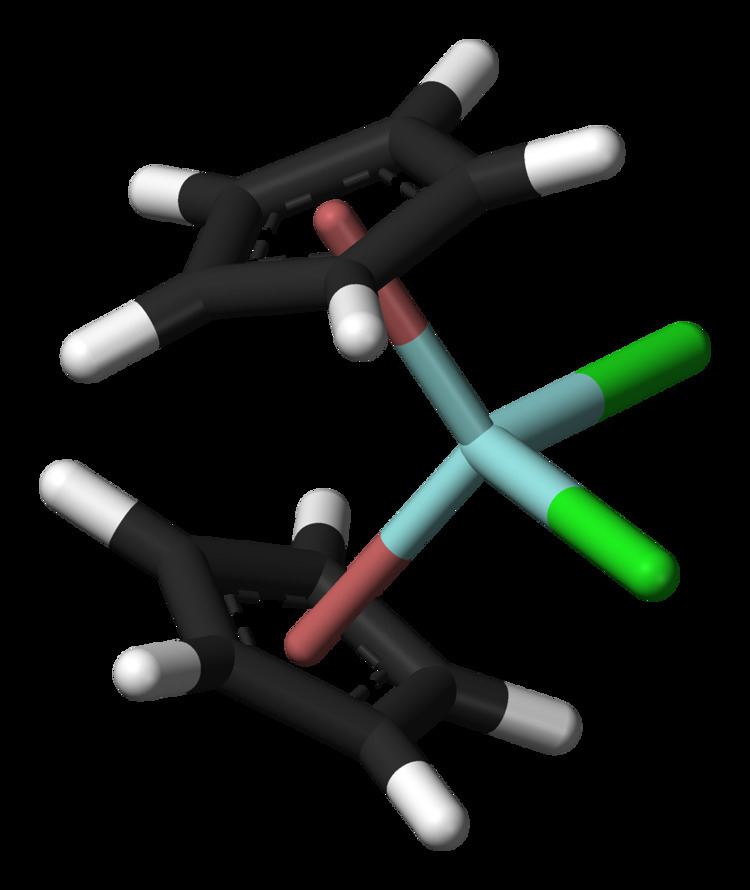 | ||
A cyclopentadienyl complex is a metal complex with one or more cyclopentadienyl groups (C
5H−
5, abbreviated as Cp−). Based on the type of bonding between the metals and the cyclopentadienyl moieties, cyclopentadienyl complexes are classified into the following three categories: a) π-complexes, b) σ-complexes, and c) ionic complexes.
Contents
Cyclopentadienyl ligand
The alkali-metal cyclopentadienyl complexes react with various transition metal compounds to form a variety of complexes that are found throughout chemistry. The Cp ligand typically coordinates metals through the donation of π-electrons. This is typically drawn as dashed bonds to the metal center through all five carbon atoms. Examples include ferrocene, [FeCp2]; the Fp dimer, [CpFe(CO)2]2; chromocene, [CrCp2]; cobaltocene, [CoCp2]; and nickelocene, [NiCp2]. When the Cp rings are mutually parallel the compound is known as a sandwich complex. This area of organometallic chemistry was first discovered in 1954 with the determination of the structure of ferrocene Some metallocenes, notably rhodocene, [RhCp2], and nickelocene, do exist in some forms where the metal-to-ring binding does not include all five ring atoms. Other metals form bent complexes, e.g., zirconocene dichloride, [ZrCp2Cl2], a catalyst for ethylene polymerization. Compounds featuring only one Cp ring are known as half-sandwich compounds or as piano stool compounds.
Bonding of Cp-ligands
Cp-ligands are generally bound via all 5 carbon atoms to a metal centre (η5-coordination π-complexes). In rare cases, the Cp unit can bond via a three-carbon π-complex, like in [(η3-Cp)WCp(CO)2]; or it can bond by one carbon in a simple σ bond, as in [(η1-Cp)FeCp(CO)2].
π-complexes
Metals and cyclopentadienyl anions connected by π bonds are called π-complexes. Unlike a normal σ bond in which two atoms share one electron pair, some or all of the π electrons of the Cp are coordinated to the metal center. π-complexes, especially in the η5-type coordination mode, are the most typical of the three types of complexes. Almost all of the transition metals, that is, group 4 to 10 metals, employ this coordination mode. η3-type π-complexes are also seen, depending on the electronic configuration of the metal centre. In this mode, three atoms are bonded to the metal as an allyl anion ligand, and the remaining two of the Cp are more like a simple alkene.
σ-complexes
σ-complexes have a direct σ-bond between the metal and one of the carbons of the cyclopentadienyl group. Typical examples of this type of complex are group 14 metal complexes such as CpSiMe3, Cp2Sn, and CpPb. CpSiMe3 is commonly used as the starting material for the synthesis of group 4 metal cyclopentadienyl complexes.
Ionic complexes
Ionic complexes primarily involve alkali metal cations and alkali earth metals cations connected to cyclopentadienyl anions. These complexes are not ionic, but the bonding is probably highly polar and often η1 bonding is indicated. Ionic type complexes are generally synthesized directly by reaction of cyclopentadiene and the metal in a non-aromatic solvent. These complexes can be good starting materials for several π-type cyclopentadienyl complexes.
Synthesis of Cp complexes
Most cyclopentadienyl complexes are prepared by treating a metal halide with sodium cyclopentadienide (NaCp). For the preparation of some particularly robust complexes, cyclopentadiene is employed in the presence of a conventional base such as NaOH. Specialized alternatives to NaCp include trimethylsilyl cyclopentadiene, (CpSiMe3), and thallium cyclopentadienide (CpTl) in an ethereal solvent. Most Cp complexes have various other ligands besides a cyclopentadienyl ligand, such as carbonyl, halogen, alkyl, and so on. Biscyclopentadienyl complexes are called metallocenes. It is often the case that these complexes are thermally stable, and they are used for various catalysts. For example, some of the early transition metal complexes, such as Cp2TiCl2 and Cp2ZrCl2 with aluminoxane as a co-catalyst, can catalyze olefin polymerization. Such species are called Kaminsky-type catalysts.
Comparison of Cp* with Cp
The pentamethylcyclopentadienyl ligand (Cp*) is an important ligand in organometallic compounds arising from the binding of the five ring-carbon atoms in C
5Me−
5, or Cp*−, to metals. Relative to the more common cyclopentadiene (Cp) ligand, Cp* offers certain features that are often advantageous. Being more electron-rich, Cp* is a stronger donor and is less easily removed from the metal. Consequently, its complexes exhibit increased thermal stability. Its steric bulk allows the isolation of complexes with fragile ligands. Its bulk also attenuates intermolecular interactions, decreasing the tendency to form polymeric structures. Its complexes also tend to be highly soluble in non-polar solvents.
Synthesis of Cp* complexes
Some representative reactions leading to such Cp*-metal complexes include:
Cp*H + C4H9Li → Cp*Li + C4H102 Cp*Li + TiCl4 → Cp*2TiCl2 + 2 LiClCp*2TiCl2 + TiCl4 → 2 Cp*TiCl3Cp*Li + Me3SiCl → Cp*SiMe3 + LiClCp*SiMe3 + TiCl4 → Cp*TiCl3 + Me3SiCl2 Cp*H + 2 Fe(CO)5 → [Cp*Fe(CO)2]2 + H2Some Cp* complexes are prepared using hexamethyl Dewar benzene as the precursor. This method was traditionally used for [Rh(C5Me5)Cl2]2.
